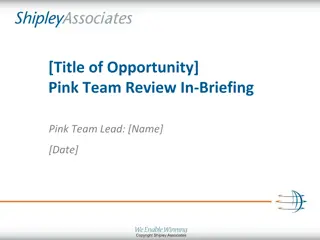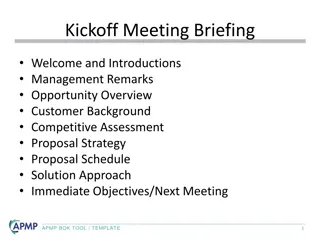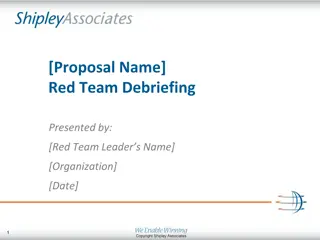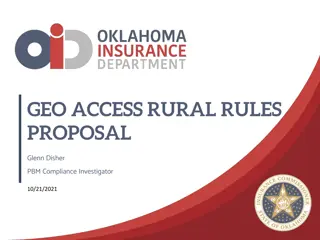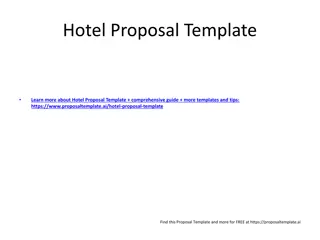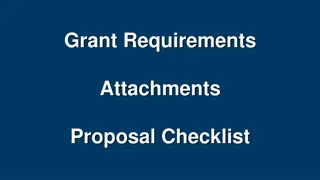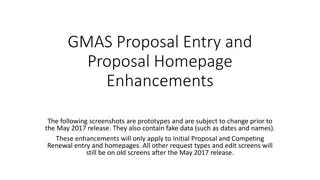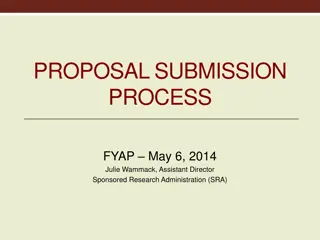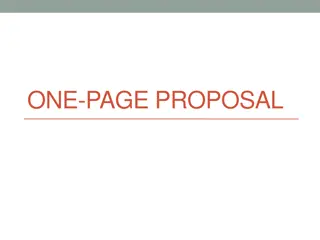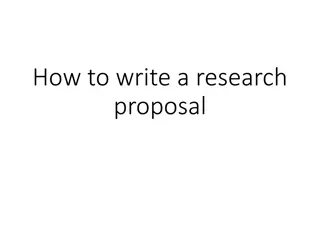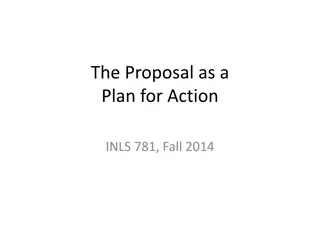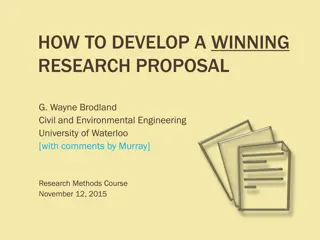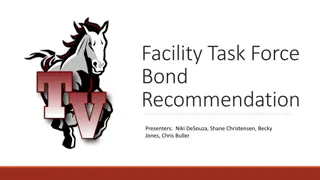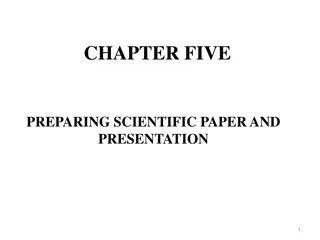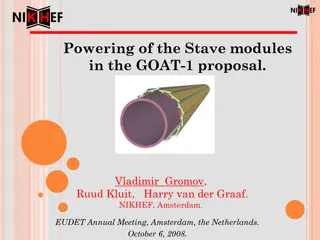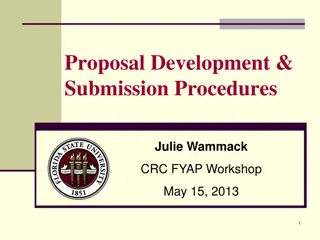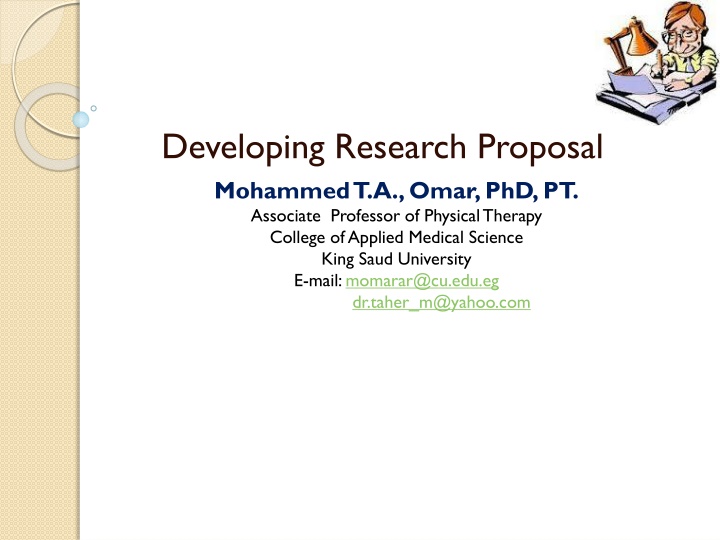
Effective Strategies for Developing a Research Proposal in Physical Therapy
Explore the key elements of crafting a successful research proposal in the field of physical therapy, covering topics like brainstorming, literature review, methodology, results, and discussion. Learn about the characteristics of good research, the importance of feasibility and ethics, and the steps involved in identifying research problems and formulating hypotheses.
Download Presentation

Please find below an Image/Link to download the presentation.
The content on the website is provided AS IS for your information and personal use only. It may not be sold, licensed, or shared on other websites without obtaining consent from the author. If you encounter any issues during the download, it is possible that the publisher has removed the file from their server.
You are allowed to download the files provided on this website for personal or commercial use, subject to the condition that they are used lawfully. All files are the property of their respective owners.
The content on the website is provided AS IS for your information and personal use only. It may not be sold, licensed, or shared on other websites without obtaining consent from the author.
E N D
Presentation Transcript
https://encrypted-tbn3.gstatic.com/images?q=tbn:ANd9GcTb6A5iFm22yuc-n-_jVpa44P-DfwUgX8YpcX2f_4apHpA3O98Hhttps://encrypted-tbn3.gstatic.com/images?q=tbn:ANd9GcTb6A5iFm22yuc-n-_jVpa44P-DfwUgX8YpcX2f_4apHpA3O98H Developing Research Proposal Mohammed T.A., Omar, PhD, PT. Associate Professor of Physical Therapy College of Applied Medical Science King Saud University E-mail: momarar@cu.edu.eg dr.taher_m@yahoo.com
Outline Characteristics of Good Research Brain storming for writing a paper Research papers elements Title page Chapter I: Introduction Chapter II: Review of literature Chapter III: Methodology & data collection procedures Chapter IV: Results Chapter V: Discussion Chapter VI: Summary and Conclusions References Appendices
What Make Good Research Paper ? Good science Good Writing Good research Good publishing
Characteristics of Good Research Feasibility/Applicability F Interest I Novelty/Originality N FINER Ethics E Relevance/relative R Honest/ transparency
Area of concern in which there is a gap in knowledge needed for practice Significance: current, hot topics, important area of concern for profession Background: one or two key studies that have been conducted related to problem
Developing of Research Problem Ides emerges (research area/topics) Brainstorming (refine ) Review of the Literature (refine) Identify Variables Formulate research problem(s)
Ides emerges The ides can be defined through: Observation/ Curiosity Clinical Experience. Literature search Discussion with therapists or other students. Discussion with patients or users of services Newspaper articles and television
Steps of Scientific Research Selection of Research area/topics No needs for study Answers found Crude Research Questions Literature review Refine Research Question No answer Hypotheses, Goals/Objectives Research Design & Sampling Work plan Data Collection & Management Planning research Interpretation of data
Variables:is something that varies. Researchers attempt to understand how and why differences in one variable are related to differences in another variable. Independent variable is the variable that has the presumed effect on the dependent variable. Dependent variable it is the consequence or the presumed effect that varies with a change in the independent variable. it is not manipulated, it is manipulated by the researcher. Extraneous Variables It interferes with obtaining clear understanding of relational or causal dynamics in the study. They can be recognized or unrecognized and controlled or uncontrolled. 9
How to Write a Good Research Proposal Research Proposal elements Title page Chapter I: Introduction Statement of the problem Purpose(s) of the study Need/ significance for the study Hypotheses Definition of Terms Chapter II: Review of literature Chapter III: Methodology & data collection procedures Chapter IV: Results Chapter V: Discussion Chapter VI: Summary and Conclusions References Appendices
Title To help readers to Decide whether to Read Not Read http://t3.gstatic.com/images?q=tbn:ANd9GcRIzPbtDkrEl-FNV7zTJgPTKQKgYZtrAUf7mMK9X_oE3SzTRweG9XCImlxT http://blog.eogn.com/.a/6a00d8341c767353ef015392b5889c970b-800wi Titles that make no sense or fail to represent the subject matter adequately?
Title Use Do not use High impact word Common name Short title ? Be verbose Reflect content* Abbreviations Specific and informative Symbols & Jargon Accurate, Simple, and complete Date / Formulae *Setting (location) * Patients (what was studied) * Intervention (treatment) *Comparator (control group) * Endpoint (outcome of interest) * Design (study design) Full stops
Title ( 18word & 102 characters)
Title ( 18word & 102 characters)
Title ( 23 word & 181 characters) ( 16 word & 87 characters)
Chapter I: Introduction The Introduction should provide readers with the BACKGROUND information needed to UNDERSTAND your study, and the REASONS WHY you conducted your experiments. Study What ? know Introduction Why? Importance What? Objective
General Rules: Introduction Constructed as Inverted Pyramid and Keep Short [3-8 paragraphs < (500 words), 1.5-2pages] 1st-2nd : Paragraph introduce broad statement 3rd -5th : Review literature 6th-7th :Paragraph explicit rationale 8th : Objective(hypotheses/aims/ questions) Using the Past-TENS when referring to work that has already been published but Present/Future- TENS when referring to your own study. Cite-peer- reviewed scientific literature or scholarly reviews ( 10 Avoid general review from textbooks Avoid unfocused review Define any specialized terms or abbreviations Avoid Plagiarism DO NOT write a literature review in your Introduction, DOcite reviews where readers can find more information if they want it. 10 years old).
Chapter I: Problem Statement The problem is associated with the purpose of the study, but it is not identical. May be in either question or declarative form The problem should be stated clearly, concisely, and definitively. Typically statement of the problems can begin with one of the following The problem (s) of this study is (are) The study is concerned with The focus of the research is on the 20
Chapter I: Purpose (objectives/Aim) of Study The purpose of the study encompasses the aims or goals the investigator hopes to achieve with the research, not the problem to be solved. To describe... To determine differences between groups... To examine relationships among... To determine the effect of... 21
Chapter I: Research Objectives The research objectives should be: Closely related to the research question Covering all aspects of the problem Very specific Ordered in a logical sequence Stated in action verbs that could be evaluated e.g. to describe, to identify, to measure, to compare, etc. Achievable, taking into consideration the available resources and time Mutually exclusive, with no repetitions or overlaps
Chapter I: Significance of the study The development of this section will attempt to show that one or more of the following is true Knowledge gaps exist between the theoretical and practical aspects of the problem. More and better understanding of exist knowledge is needed in the problem area. Validation of existing knowledge A solution to the problem needs to be found
Chapter I: Hypothesis Hypotheses: formal statements of expected relationships among variables Hypotheses are scientific explanation that can be tested Hypotheses can be supported or disproved by the evidence collected. Researchers often develop their project to test a hypothesis rather than answering a question Each hypothesis represents a unit or subset of the research problem Hypotheses are formulated before the study is conducted because they provide direction for the collection, analysis, and interpretation of data
Types of Hypotheses Associative vs. causal Simple vs. complex Non-directional vs. directional Null vs. Research Null hypothesis: States there is no difference or relationship between variables; also called statistical hypothesis Research hypothesis: States what researcher thinks is true; there is a relationship between two or more variables
Test your Self EXAMPLE In a clinical trial of aerobic and endurance exercises, the null hypothesis might be that the aerobic exercises is no better, on average, than the endurance exercise. We would write H0: There is no statistically significant difference between the two exercises on average. If we have control group(subjects who do not exercise) We would write H0: There will be no statistically significant difference between subjects who exercise and subjects who do not The alternative hypothesis might be that: the aerobic exercise has a different effect, on average, compared to that of the endurance exercise. We would write H1: the aerobic exercises is better than the endurance exercises, on average.
PROBLEM (VS) HYPOTHESIS Hypothesis is an assumption, that can be tested and can be proved to be right or wrong. A problem is a broad question which cannot be directly tested. A problem can be scientifically investigated after converting it into a form of hypothesis.
Research problem : Exercises No evidence exploring the effectiveness of spinal stabilization exercises (STE) in idiopathic scoliosis (IS) associated with low back pain (LBP) in relation to pain, disability, quality of life (QOL) and back muscle endurance The STE will be performed for 8-week in form of Supervised PT Exercises Non-supervised Exercises [Home-based Exercises(HBE)]
HYPOTHESIS: Exercises Bases on your understanding formulate the following: 1- Purposes (S) of the study 3-Hypothesis 3-1: research hypothesis 3-2: null hypothesis
Purpose: Exercises The purpose is to investigate whether or not 8 weeks of weekly supervised PT compared to 8 weeks of an unsupervised home exercise program would reduce pain intensity and disability and improve QOL and back muscle endurance in in participants with AIS and LBP.
Research questions : Exercises The following research questions were addressed in this study: 1. Would there be differences in pain intensity, disability, QOL, and back muscle endurance between participants with AIS and LBP who receive 8 weeks of weekly supervised PT compared to those who receive 8 weeks of an unsupervised HBE? Would there be improved pain intensity, disability, QOL, and back muscle endurance in participants with AIS and LBP, regardless of group, after 8 weeks of intervention? 2.
Hypotheses : Exercises The hypotheses of the study were as follows: Participants with AIS and LBP who receive 8 weeks of weekly supervised PT would have significantly improved pain intensity, disability, QOL, and back muscle endurance following the intervention compared to those who receive 8 weeks of an unsupervised HBE. 1. Participants with AIS and LBP, regardless of group, would have significantly improved pain intensity, disability, QOL, and back muscle endurance after 8 weeks of intervention. 2.
Hypotheses : Exercises The null hypotheses of this study were as follows: There would be no differences in pain intensity, disability, QOL, and back muscle endurance following the intervention between participants with AIS and LBP who receive 8 weeks of weekly supervised PT and those who receive 8 weeks of an unsupervised HBE. 1. Participants with AIS and LBP, regardless of group, would demonstrate no improved pain intensity, disability, QOL, and back muscle endurance after 8 weeks of intervention. 2.
Chapter I: Delimitation/Limitation Potential weaknesses of the study researchers could not control Bounds you set for the study, things researchers could control Define scope of the study , things Limitations Delimitations
Chapter I: Delimitation/Limitation Number & kinds of subjects Treatment conditions Tests, measures, instruments used Type of training (time and duration) Research design and methods Sample problem Uncontrolled variables Generalizability of the data Reliability and validity of research instruments approach, Limitations Delimitations
Chapter I: Definition of Terms Define each technical term as it is used in relation to your research project. Define the operational terms and concept Used specialized dictionaries, and citations Should be arranged alphabetical Definition of Terms Spinal stabilization exercises, low back pain , pain intensity, quality of life, disability, scoliosis , supervised exercises, non supervised exercises , back muscles endurance


